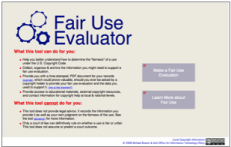...is a limitation on the exclusive rights of the copyright holder. Detailed in Section 107 of U.S. Copyright Law, fair use encourages the use of a copyrighted work without seeking permission from the copyright holder for the purposes of criticism, comment, news reporting, teaching (including multiple copies for classroom use), scholarship, or research. Four factors must be weighed for each instance in which a copyrighted work may be used. The four factors include the following:
- Purpose and character of the use
Non-profit, educational use of a work is more in favor of fair use than for profit, commercial use of a work.
Using factual works is considered more fair than using highly creative works.
- Amount and substantiality of the work to be used
Using small amounts of a work is more fair than using larger amounts or the "heart" of the work.
- Effect on the market or value of the work
Do the first three factors indicate that there is an effect on the market for the work?

